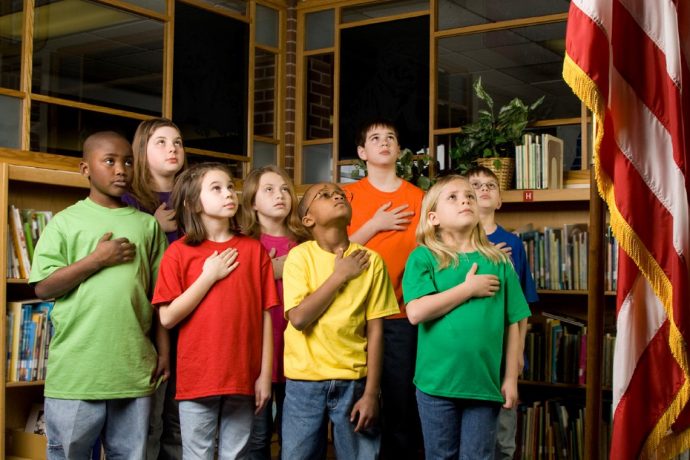At the Celebrate Freedom concert in Washington, DC, earlier this month Donald Trump told the crowd that, “In America, we don’t worship government, we worship God.” The telling liturgical response from the gathered congregation was a chant of “USA! USA!”
Indeed.
Three weeks after I first moved to the United States with my family, and one week into our American public school adventures, my youngest daughter asked me, “Mummy, did you know that we pray to the flag every morning at school?”
Any discussion of an American “civil religion” needs to take account not only of history and of ideology, but of the religious rituals that surround our secular cult. Walk into many public elementary schools in America a few minutes after the opening bell, and you will know: we already have an established religion in this country, and its graven image is the flag. Our youngest child recognized it right away.
Consider the rituals surrounding our worship of the flag. In my church, when the Gospel is read during a sacramental service, all of the people in attendance who are able stand, and turn towards the book, which is elevated in their midst. At the announcement of the reading, many mark their heads, lips, and hearts with a cross.
We do the same thing for the Pledge of Allegiance. The US Flag Code advises:
#172. The Pledge of Allegiance to the Flag, ‘I pledge allegiance to the Flag of the United States of America, and to the Republic for which it stands, one Nation under God, indivisible, with liberty and justice for all.’, should be rendered by standing at attention facing the flag with the right hand over the heart.
After an item has been blessed in divine service – palm leaves, linens used to dress or to wipe up at the altar, a metal chalice – and has reached the end of its useful service, the preferred method of its disposal is consumption by fire. Palm leaves are often turned to ashes for use the following year on Ash Wednesday, the beginning of the Christian holy season of Lent. Chalices may be melted down and recast.
We do the same for the flag:
#176 (k) The flag, when it is in such condition that it is no longer a fitting emblem for display, should be destroyed in a dignified way, preferably by burning.
On the campaign trail last year, then-candidate Trump borrowed the language of flag and religion to cast a utopian vision of America as “one people, under one God, saluting one American flag.”
Baptist minister Francis Bellamy wrote the Pledge of Allegiance in 1892 as a ceremonial recitation for schoolchildren celebrating the 400thanniversary of Columbus’ arrival in the Americas. As Jeffrey Owen Jones writes:
In Bellamy’s later accounts of the sultry August evening he composed the pledge, he said that he believed all along it should invoke allegiance. The idea was in part a response to the Civil War, a crisis of loyalty still fresh in the national memory. As Bellamy sat down at his desk, the opening words—”I pledge allegiance to my flag”—tumbled onto paper. Then, after two hours of “arduous mental labor,” as he described it, he produced a succinct and rhythmic tribute very close to the one we know today: I pledge allegiance to my flag and the Republic for which it stands—one Nation indivisible—with liberty and justice for all.
Soon afterwards, the possessive pronoun was removed so that all children would know that they were pledging their allegiance to the same flag, that of the United States of America. On its fiftieth anniversary, the Pledge was incorporated into the National Flag Code. Ten years later, in the shadow of the Cold War, two weighty words, “under God,” were added.
It has become the creed of the state religion, taught early and often to our children.
The Very Revd Will H. Mebane, Jr., Interim Dean at St Paul’s Episcopal Cathedral in Buffalo, NY, grew up in the South in a fairly conservative religious household. He encountered the Flag at school and at church, at Boy Scouts – “there was a whole lot of saluting of the flag,” he told me.
In high school, where he and his friends were among the first African Americans to integrate a previously all-white school, the Pledge was recited before football games; then the National Anthem was sung and the band played Dixie. Will and his friends petitioned the administration to tone down the southern jingoism, but were ignored.
It was around that time that he became aware that the same flag that he had grown up saluting featured prominently in the ceremonies of the KKK. How could he recite a pledge of allegiance that talks about liberty and justice for all when white supremacists were using the same symbols to profess and promote their hatred?
Still today, he says, “For me, the words ring hollow. They do not speak to my experience as a Black man in this country, with two African American sons, and Black colleagues, and Black friends—it is a lie.”
All of this preceded the realization, as his faith matured, that the flag and the Pledge and the Anthem were all idols, and that people seem often to be more interested in worshipping these idols than the cross of Christ.
Jon White, also an Episcopal priest, addressed the issue of idolatry directly:
I do not say [the Pledge of Allegiance], and I have an opportunity each week at Rotary to not do so. For me, I understand my only allegiance to be to Christ. We proclaim one Lord as Christians and I don’t believe that allows for a hierarchy of allegiances. I’ve only ever been asked about it once and the asker accepted my answer readily. I don’t demand it of others or even preach it overtly, but I think it is the most Christian response allowable.
I believe in being a good citizen and participating in communal and political life. And I think being a veteran allows me more space than others might have to follow this belief without pushback.
We have a saying in my own religious tradition: that “praying shapes believing.” In other words, the words, symbols, and rituals that we use to express our faith become our faith, and predict our actions. So when a child comes home convinced that she is “praying to the flag,” what are we teaching her to believe, about her country, about her religion, and about the real possibility of “liberty and justice for all”?





